Wondering how to grow vegetables in limited space? With a little creativity it's probably easier and more productive than you might think.
http://www.ecohome.net/guide/growing-food-small-spaces
As summer approaches, many of us look forward to the unmistakable taste of fresh, locally grown vegetables and fruit, especially those from our own soil. For those of you who would like to grow your own but have limited space, don't despair. Your dream of home grown food is still within reach.
You may be wondering how to grow vegetables if you have little to no space with full sun exposure, but many vegetables will tolerate partial shade, and a few could even be considered 'shade vegetables' as they won't tolerate full sun exposure.Maybe you live in an apartment with not much more than a balcony, but you love fresh veggies and would still like to grow your own - no problem! Here are some tips to help make your urban garden a success.
Containers, containers, containers:
If you have limited outdoor space, be it a small yard, shared courtyard or balcony, container gardening may be for you.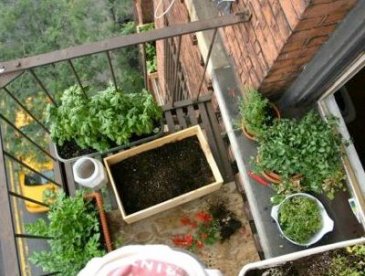 |
|
NYC balcony garden © Tashian
|
With the right amount of sun exposure it's even feasible to successfully grow small fruit trees or bushes this way. In my day I have seen both lemon trees and blueberry bushes thrive in above ground planters.
Container gardens are also extremely space efficient as every ounce of soil in your container will count as no growing space will be wasted underfoot as you care for and harvest your plants.
Another great thing about container gardening is your ability as the gardener to chase the sun if necessary, as containers can be moved throughout the day. If you have no time to be moving containers whilst life carries on around you, no problem, plant for the amount of sun you have.
While it's true that many plants will demand a minimum of 6 hours of direct sun per day there are several 'shade vegetables' that will tolerate or thrive in partial shade and dappled sunlight.
A few things to consider when container gardening:
- 'Upcycling' can lead to some very interesting containers - steel pasta strainers are great for kitchen herbs, reclaimed vintage boxes will add flair to your vegetative stylings and even upcycled plastic totes can make great planters if you're more concerned with utility than style. You are limited only be your imagination and preferences. You'll want to remember to allow for drainage, so if necessary drill holes or otherwise puncture the bottom of your chosen containers.
- Almost any plant will grow in a container if the container is big enough.
- Straw bales themselves can be used as containers for gardening. See how this is done here.
- Be sure to provide enough water and food when gardening in containers, as soil in containers will dry out faster and nutrients tend to flush through them with greater speed than their in-ground counterparts.
- Assess your sun exposure and plant accordingly.
Vertical Gardening: When it's time to grow up (or down)
Ah, vertical gardening. There are so many ways to grow upwards - from a traditional trellis to a recycled pallet planter to a hanging hydroponic window garden. The options for vertical gardening are vast and require only some creativity.Which edibles lend themselves to vertical gardening you may be wondering, well I'm happy to report that the list is long. Here are just a few to get you started:
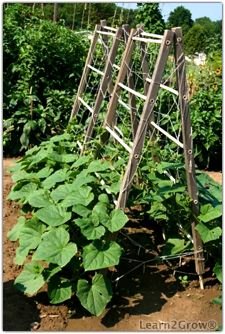 |
|
vertical garden © Jessie Kieth
|
- Tomatoes: Cherry tomatoes in particular (but most varieties will do) are very happy to grow in an upward fashion when given the right amount of support. Recycled nylons are fabulous for tying your plants to their upward structures as they are flexible and will result in the least amount of stress on the plant where they are attached. Maybe you don't wear nylons or your nylons are far too valuable to use in your urban garden, no worries, pick some up at the thrift store, they'll cost next to nothing.
- Winter squash and melons: These plants vine naturally and will happily grow towards the sky. Again, they will need adequate support, particularly as they begin to fruit.
- Peas and pole beans
- Cucumbers
- Asian greens, salad greens, strawberries and kitchen herbs will all happily grow in nothing more than a recycled pallet on its side. Instructions for that can be found here.
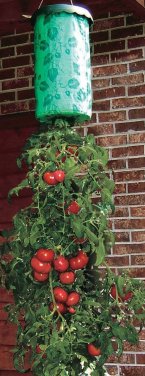 Hanging tomato plant via Vancouver Sun
Hanging tomato plant via Vancouver Sun
- Greens, strawberries or kitchen herbs will also happily grow in sections of rain gutter which can either hang or be fixed to the side of almost any southward facing structure or in a network of hanging bottles in a south facing window as seen here. Hanging rain gutter garden instructions here.
- Potatoes. Yup, even potatoes will grow vertically, if given the right container to do so in. Imagine you're using a clean garbage can with all kinds of holes drilled in the bottom. Throw down a few inches of soil and compost, add your cut and cured pieces of seed potatoes and cover them with 6 more inches of dirt. Water. When the aerial parts of the plant have reached about 6 -8 inches, add more soil leaving only a few inches of green exposed. This cycle can be repeated several times throughout the season. When the plants turns brown and dies it's time to harvest. The potatoes on the very top will be smaller and more delicate than those on the bottom, much like the gourmet "new" potatoes available at the store for an elevated price. I have heard tell of vertical potatoes growing in a straw filled container (rather than soil) allowing for easier harvest and I plan to try it this year.
- Try hanging planters: Strawberries will thrive in hanging baskets, even tomatoes will happily grow upside down out of the bottom of a hanging bucket. Our ground covering strawberries do little more than make for fat, happy chipmunks, hanging them means you might get to eat some too. DIY upside down tomato planter instructions here.
Raised beds and square foot gardening:
If your gardening space is big enough for raised beds, they can be a great way to maximize space and effort. Not only can raised beds accommodate more plants per square foot, but gardening in a raised bed greatly reduces the need to weed. It also makes weeds much easier to uproot throughout the season, which can be a real blessing for your back.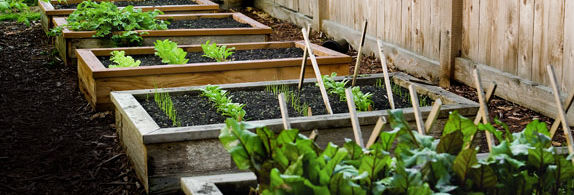 |
|
Raised bed garden via Allmash
|
- An extended growing season. A raised bed will warm up faster than the ground in the spring and in the fall your bed can easily be tented to extend your growing season by a few weeks or so.
- Location, location, location: Grow food in the location of your choice regardless of soil conditions as you will be adding your own.
- Raised beds offer excellent drainage.
- Soil compaction in no longer an issue, so working the soil and weeding will be much easier.
- Every square inch of soil will go towards food production as none will be wasted underfoot.
- Depending on how high you choose to build your raised beds, you could completely eliminate the need to bend over. At worst, even if your raised beds are only a foot and a half high, you won't be bending as far.
Community gardens
No south facing window, balcony or yard? Consider a community garden, it's a great way to grow food while strengthening relationships with neighbours. If there isn't already a community garden in your neighbourhood, might there be a vacant lot on which to start one?One thing is for sure, learning how to grow vegetables with others in your community while sharing information and resources, will do more than put food on the table. Collective gardening or even just sharing gardening space will help to build and strengthen relationships within your community.
A community garden is also a great way to give kids exposure to food production that they might not otherwise get. We will face many challenges in the future around the issues of natural resources and food production. The ability to grow food in one capacity or another is a skill that may become more than handy for future generations.



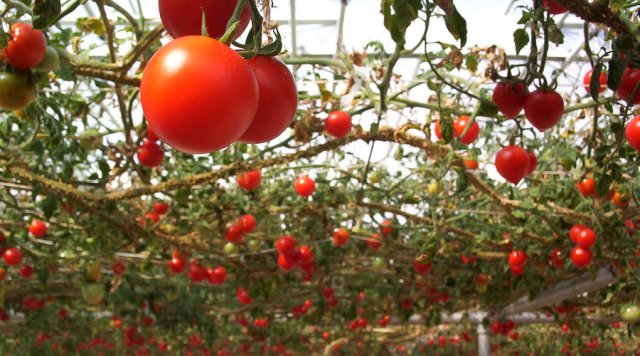


0 comments:
Post a Comment